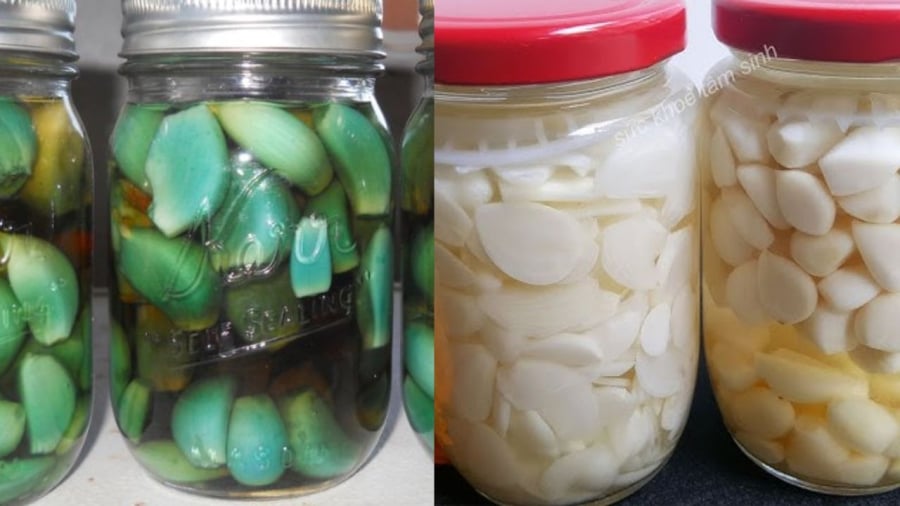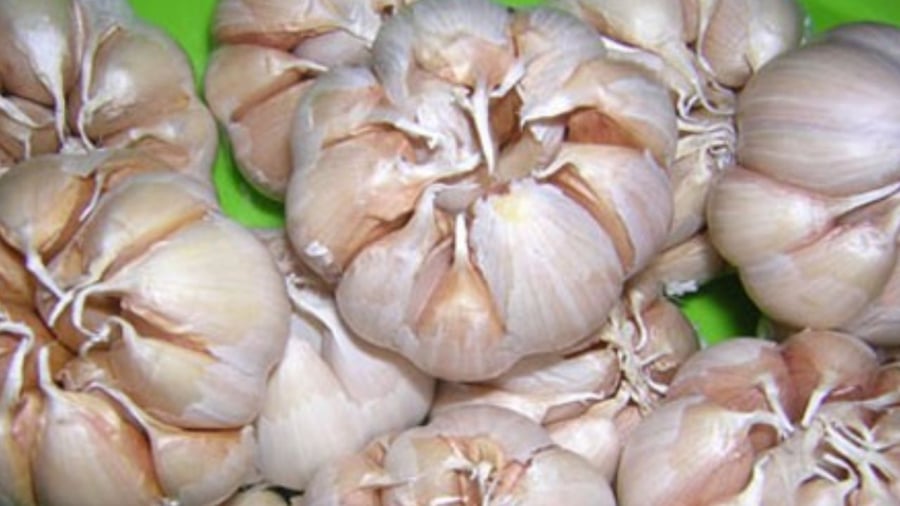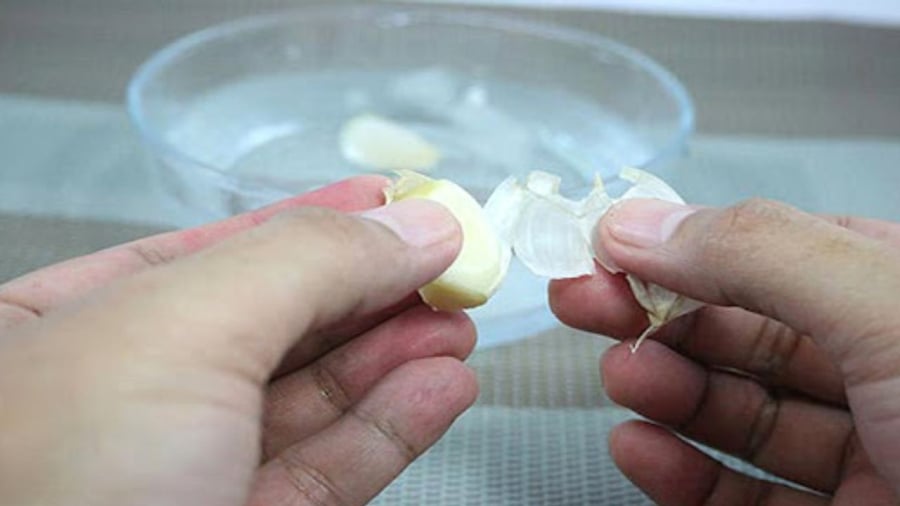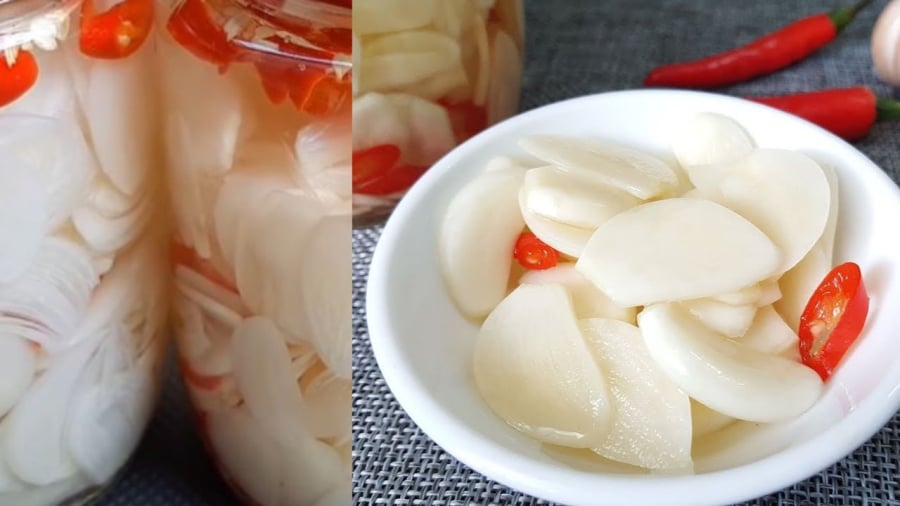Pickled garlic is a common side dish in many Vietnamese meals. However, many people who pickle garlic at home often encounter garlic turning green, blue, or purple, which is unappetizing and raises safety concerns. So, why does pickled garlic turn green, and how can you prevent it?
1. Why Does Pickled Garlic Turn Green?
It is common for garlic to turn green when pickled, especially with fresh garlic. This is not an indication of spoilage or toxicity but a natural chemical reaction that occurs during the pickling process. Specifically, there are three main reasons for this phenomenon:
1.1 Chemical Reaction Between Sulfur Compounds and Acids
Garlic contains high levels of sulfur compounds, particularly alliin and alliinase. When garlic is cut, crushed, or sliced, these two compounds react to form allicin, the compound responsible for garlic’s distinctive pungent odor and various health benefits.

When garlic is exposed to the acidic environment of vinegar, these sulfur compounds can further react, forming polysulfides. These compounds, when combined with naturally occurring amino acids and trace metals in garlic (such as copper and iron), result in the formation of green, blue, or purple pigments.
1.2 Garlic Is Immature or Not Fully Dried
Freshly harvested garlic or garlic that has not been thoroughly sun-dried tends to have higher moisture and enzyme levels. This increases the likelihood of reactions between the compounds within the garlic during pickling. Younger garlic is more prone to color change than older garlic.
1.3 Type of Vinegar and Pickling Conditions
Strong vinegar (with a high acetic acid concentration) or low pH can also stimulate color change in garlic. Additionally, pickling garlic in metal containers or in a humid environment can enhance oxidation-reduction reactions, leading to green garlic.
2. Is It Safe to Eat Pickled Garlic That Has Turned Green?
YES, it is safe. Pickled garlic that has turned green is not toxic and is perfectly safe to consume. The color change is purely a natural chemical reaction and does not affect the nutritional value or pose any health risks.
However, if you find the color unappealing or are concerned, you can follow the tips below to prevent garlic from changing color during pickling.

3. Tips for Pickling Garlic to Prevent Greening
Here are some helpful tips to ensure your pickled garlic stays white, crisp, and safe:
3.1 Select the Right Type of Garlic
Opt for older garlic that has been thoroughly sun-dried: Older garlic has lower enzyme levels, reducing the likelihood of color-changing chemical reactions.
Ly Son garlic or “lonely garlic” (a type of garlic with large cloves) usually yields better and more aesthetically pleasing results.
3.2 Proper Pre-Treatment
Peel and rinse the garlic, then soak it in a mild salt water solution (10-15 minutes) to remove impurities.
Next, soak the garlic in warm water (50-60°C) for 3-5 minutes, then drain and ensure it is completely dry. This step reduces enzyme activity and minimizes color change.
You can also soak the garlic in diluted sugar water and change the water 2-3 times to reduce its pungency before pickling in vinegar.

3.3 Blanching (Optional)
For added assurance, you can blanch the garlic in boiling water for 30-60 seconds, then immediately plunge it into ice water to retain crispness and reduce the likelihood of greening. However, be careful not to overcook, as this can affect its texture.
3.4 Use Vinegar with a Stable pH
Traditional rice vinegar or pure apple cider vinegar has a moderate acidity level and is less likely to cause a green reaction compared to industrial vinegar.
Before pickling, gently heat the vinegar with sugar and salt until dissolved, then allow it to cool completely. This step reduces the initial acidic “shock” to the garlic.
3.5 Use Clean and Dry Pickling Jars
Use clean, sterilized glass jars, avoiding metal or aluminum containers that can promote oxidation reactions.
Ensure the garlic is completely submerged in vinegar to prevent spoilage or mold growth.

4. Recipe for Pickling Garlic to Keep It White
Ingredients:
300g older peeled garlic cloves
300ml rice vinegar or apple cider vinegar
2 teaspoons sugar
1 teaspoon salt
1 sterilized glass jar
Instructions:
After pre-treating the garlic as mentioned above, ensure it is thoroughly dry.
Prepare the pickling solution by heating the vinegar, sugar, and salt together until dissolved, then allow it to cool completely.
Place the garlic cloves in the jar, pour in the pickling solution to cover the garlic, and seal the jar.
Store in a cool, dry place or in the refrigerator. The garlic should be ready in 5-7 days.
Good luck, and happy pickling!






























